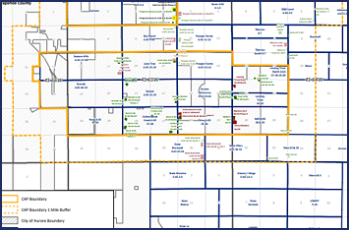Digital Information Portal
Box Elder Comprehensive Area Plan
This digital information portal is intended to share information and updates about the Box Elder Comprehensive Area Plan (CAP) for oil and gas development proposed by Crestone Peak Resources, located in rural, undeveloped land within the City of Aurora. In the future, the site also will enable registered users within the CAP area to provide feedback on the proposal throughout the consideration process.
This site will be updated regularly with new information, and includes links to other resources, a feedback form for users that provide their name and email address and a way for anyone to sign up to be notified of updates automatically via email.
Box Elder Comprehensive Area Plan Final Submittal Documents
Box Elder CAP Community Meeting
What is a Comprehensive Area Plan?
A Comprehensive Area Plan (CAP) is a holistic, consultative process for planning and permitting locations for the production of oil and gas in Colorado by the Colorado Oil and Gas Conservation Commission (COGCC), under COGCC Rule 314. This approach to planning and permitting was created by Senate Bill 19-181.
The COGCC’s mission is to regulate the development and production of the natural resources of oil and gas in Colorado in a manner that protects public health, safety and welfare, including protection of the environment and wildlife resources. Because the CAP process supports this mission, COGCC is encouraging oil and gas operators to develop and submit CAPs for review, rather than taking the traditional approach of permitting one oil and gas location at a time.
The CAP approach can result in fewer well sites, less land disturbance, better consideration of cumulative impacts of energy production and more protection for disproportionately impacted communities, compared with the traditional oil and gas development approach.
The Crestone Peak Resources Box Elder Comprehensive Area Plan
Crestone Peak Resources, a Denver-based energy company known as a leader and innovator in responsible energy production in Colorado, has submitted an application for the Box Elder Comprehensive Area Plan to the COGCC for initial review. When COGCC deems the application complete, it will be posted on this portal.
Crestone is the first Colorado oil and gas producer to submit a complete CAP application that meets all of the requirements of COGCC regulations, continuing a history of leadership in protecting the environment and public health while working cooperatively with state and local regulators.
The Box Elder CAP covers an area of approximately 55 square miles located in mostly rural and currently undeveloped areas within the boundaries of the City of Aurora. The nearby unincorporated community of Watkins, just east of the CAP area, once was known as Box Elder, for the maple tree variety commonly found in Colorado, which is the reason for the CAP name. Box Elder Creek flows through a portion of the area.
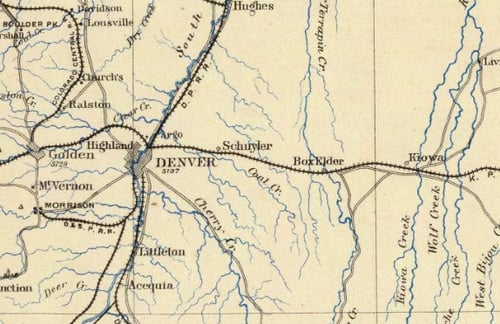

In reviewing CAP applications, COGCC also takes into account land use and natural resources in a one-mile perimeter around the CAP area, referred to as the buffer zone. Map 1 on the right shows the Box Elder CAP area, including buffer zone, with both existing and proposed oil and gas locations. Proposed locations shown here are subject to change as COGCC reviews the application.
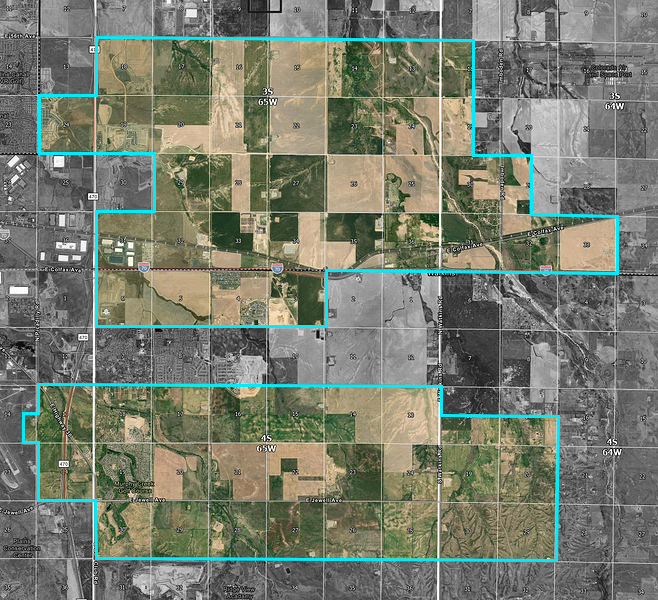
Box Elder CAP Overview
As noted, the Box Elder CAP includes a mix of existing oil and gas locations, already present in the area, plus proposed new ones.
- 20 sites of future operations in a 55 square mile CAP area
- 25 existing sites in the CAP that will not be expanded
Crestone has an oil and gas operator agreement with the City of Aurora (which can be found here). Originally issued to our predecessor company, the agreement gives Crestone local approval for well site locations, but the City must still review site-specific plans before giving administrative approval to construct and operate oil and gas locations within the city limits, some of which will be incorporated into the Box Elder CAP.
Compared with traditional oil and gas development planning, the CAP process enables oil and gas operators to consolidate locations, eliminate redundancies, build fewer well pads and disturb less land area, while also taking future community development into account. Crestone’s Box Elder CAP features the following footprint reductions, subject to change during the consideration process, compared with what is permitted by its existing Aurora operator agreement:
- Eliminates 16 planned well pad locations or expansions in the CAP boundary through consolidation
- Reduces disturbed acreage by 55 percent
- Eliminates the need for many miles of access road and pipelines
- Reduces emissions of volatile organic compounds (VOCs) by 44 percent
- Reduces water use for drilling and completions by 36 percent
If COGCC approves Crestone’s Box Elder CAP, oil and gas development will start on the west side of the CAP area, where commercial and residential development is planned, and move east. This will allow the construction, drilling and completion phases for these well sites to be completed sooner, making way for the development that’s expected to follow and avoiding or minimizing future land-use conflicts.
Land in and around the Box Elder CAP area is sparsely populated, mostly rural and undeveloped at this time, although development is expected in the future. Current uses include farmland, rangeland and short-grass prairie.
COGCC regulations, adopted following the passage of SB 19-181, provide for a 2,000-foot setback from homes and schools to any new oil and gas well sites but provides that well sites closer than 2,000 feet may be approved when they are part of a comprehensive area plan or when a COGCC hearing finds substantial protections for public health and the environment in place at a proposed site. Thirty-three of the 48 existing and planned well sites are more than 2,000 feet from any residence.
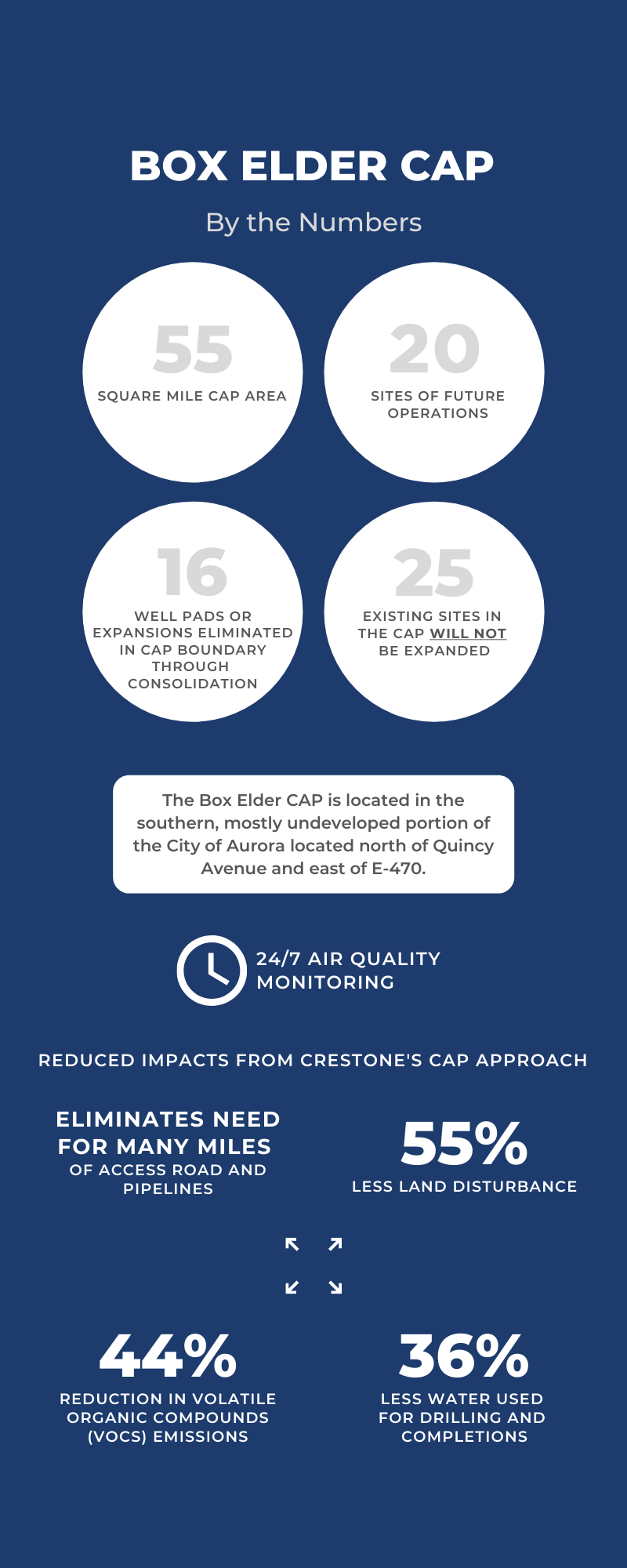
Consideration Process for Crestone’s Box Elder Comprehensive Area Plan
COGCC Rule 314 provides a clear process for consideration of CAP applications, including multiple opportunities for public comment and for consultation with other relevant state agencies and affected local governments. Crestone filed an application with COGCC for the Box Elder CAP on Friday, July 9th. The CAP application and consideration process typically takes 255 to 285 days, including time spent preparing the application before it’s submitted to COGCC.
Opportunities for Public Comment on Crestone’s Box Elder CAP Application
COGCC's CAP consideration process allows multiple opportunities for public comment. These include:
- The 60-day public comment period during which the public may comment on the application by sharing feedback on the COGCC website. All comments will be posted on the website unless they contain confidential information.
- The public meeting that Crestone will be required to hold as part of the consideration process, with owners or tenants of residential building units within the CAP area. The meeting will take place at a date, time and location reasonable for most invitees to attend, and will include the schedule of operations, maps of the CAP area and well site locations within and adjacent to it, and a review of best management practices to minimize any adverse impacts on air, soil, water or biological resources resulting from oil and gas operations.
- Public comment will be accepted at the COGCC hearing on the application.
- Public comments can be made by emailing the Crestone Community Relations team at communityrelations@crestonepr.com
- Crestone also encourages public input via this digital information portal, using the feedback form.
Local Process
 |
While all of the proposed well sites located within the Box Elder CAP have their initial siting approved as a result of Crestone’s operator agreement with the City of Aurora, specific site plans will require separate reviews and approvals by city staff.
|
Benefits of Colorado Oil and Gas Production
Oil and gas production in Colorado provides the essential energy we all use every day. Because Colorado has strict oil and gas regulations that prioritize protecting public health and the environment, energy produced here will have fewer impacts than energy produced in places where regulations aren’t as strict.
A March 2019 study by the Global Energy Management Program at the University of Colorado Denver found that the Colorado oil and gas upstream and midstream activity exceeds 89,000 jobs and $10.8 billion in employment income. The value of industry output is estimated at $19 billion in 2017, meaning the energy industry has a substantial positive impact on the Colorado economy.
One beneficial impact of our activities is the financial support we provide for state and local governments through tax revenue produced by our operations. At the state level, our operations provide ad valorem tax which helps pay for essential government services in the communities where we operate – first responders, schools, library and water districts, to name a few. At the local level, our operations also provide revenue from property taxes.
We’re also committed to building stronger Colorado communities by investing in the places where we live and work. Supporting local economies and non-profit partners helps us deliver on our promise of positive social impacts that add value and make communities better off due to our presence. We’re active supporters of the Adams County Fair, Arapahoe County Fair, and Aurora Public Schools Foundation, to name a few.
 |
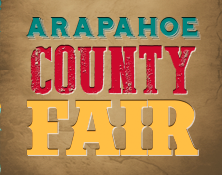
|
|
Impacts
Oil and gas production has temporary impacts on nearby communities, which we strive to avoid, minimize or mitigate, going beyond what’s required by state and local regulations. Following the Comprehensive Area Plan approach is an important mitigation step because it enables us to consolidate well sites. Additionally, Crestone has committed to using no more than two drilling rigs and two completion rigs in the CAP area at any one time.
Impacts are minimized when oil and gas production occurs in sparsely populated, mostly rural and undeveloped areas. While this is not always possible, it is the case for most of the Box Elder CAP. Oil and gas development will move from west to east under the plan, so that construction, drilling and completions can be finished sooner, making way for the residential and commercial development that’s expected to follow.
Crestone takes a responsible approach to producing oil and natural gas and is committed to finding solutions, making investments and adopting new technologies to safeguard public health, the environment and quality of life for all Coloradans. Crestone uses several best management practices to reduce impacts, including these steps:
- Deploying real-time, continuous air quality monitoring through Project Canary technology, which alerts Crestone to any abnormal readings so the company can take immediate action. Read more here.
- Using an innovative, synthetic base, high-performance drilling fluid which is virtually odor-free, non-toxic and readily biodegradable, meaning it’s environmentally friendlier and results in less waste. Read more here.
- Crestone uses a vent-free fully enclosed flowback process for all of our wells. This captures temporary natural gas emissions coming from a well just before it goes into production. Gas is directed to a pipeline to be transported off-site, rather than vented or flared, reducing any potential impact on air quality.
- Shielding derrick lights or orienting them downward to minimize light pollution and visual impacts on neighbors while maintaining a safe work environment for our contractors and employees.
- Utilizing Quiet-FleetTM hydraulic fracturing technology and electric drill rigs, when line power is available, to decrease noise.
- Consolidating well pads along the same corridor to utilize the same truck route and creating a traffic plan to eliminate truck traffic during school bus pick-up and drop-off times and rush hour.
Stay Informed
This digital information portal will be updated regularly with new information, including status of the application consideration process, public meetings and comment opportunities, and milestones and events.
Enter your email address here to receive automatic notifications whenever new content is posted:
Contact the Civitas Community Relations Team
Email: CommunityRelations@civiresources.com or BoxElderCAP@civiresources.com
Phone: 720-279-9842
Emergency: 1-800-578-5610
Share Feedback on Crestone’s
Box Elder CAP
Anyone, including building unit owners and tenants within the Box Elder CAP area, are invited to share feedback on the plan using the form below. Once the COGCC has declared the application complete. Crestone’s plan will be posted on the COGCC website at that time, and this digital information portal will be updated with a link to the plan and more information about what it includes.
Anyone can share feedback on Crestone’s CAP plan on the COGCC website once the public comment period begins. Feedback also will be part of the public meetings that Crestone will hold during the public comment period and at a COGCC hearing that is part of the consideration process.
